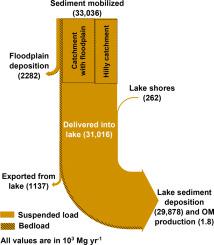当前位置:
X-MOL 学术
›
Geomorphology
›
论文详情
Our official English website, www.x-mol.net, welcomes your feedback! (Note: you will need to create a separate account there.)
Consolidated sediment budget of Lake Tana, Ethiopia (2012–2016)
Geomorphology ( IF 3.9 ) Pub Date : 2020-12-01 , DOI: 10.1016/j.geomorph.2020.107434 Hanibal Lemma , Amaury Frankl , Mekete Dessie , Jean Poesen , Enyew Adgo , Jan Nyssen
Geomorphology ( IF 3.9 ) Pub Date : 2020-12-01 , DOI: 10.1016/j.geomorph.2020.107434 Hanibal Lemma , Amaury Frankl , Mekete Dessie , Jean Poesen , Enyew Adgo , Jan Nyssen

|
Abstract Lake sediment budgeting is a vital tool to better understand catchment sediment fluxes. It allows assessing lake lifetime and can be used to design improved catchment management plans. Over the past few years, we collected sediment and runoff discharge data at fine spatial-temporal resolutions for the Lake Tana Basin (LTB), Ethiopia. Based on these data, this study presents a consolidated sediment budget of Lake Tana, following the proof of concept by Lemma et al. (2018). Sediment yield (SY) was quantified for 15 rivers and 2 lake outlets based on 12,671 suspended sediment concentration (SSC) samples, making this the most complete dataset for Lake Tana. In particular, we investigated seasonal and temporal patterns of sediment dynamics and the role of lakeshore floodplains. The latter was done by comparing the SSC measurements at upper and lower borders of the floodplains. Sediment rating curves were prepared that account for land cover conditions and rainfall seasonality. SY calculations for the main contributing rivers take bedload fluxes into account by means of a bedload rating curve. As a result, the gross annual sediment mass mobilized on the hillslopes of LTB was 33.30 Mt (9.93 Mt from ungauged rivers), dominantly from large river catchments in the southern and eastern parts of LTB. SSC and SY are generally larger at the beginning of the rainfed cropping calendar (May–June). By the end of rainfed cropping calendar (September–October), SY decreases. Floodplains store 2.28 Mt suspended sediment whereas annually an average SY of 31.02 Mt entered the lake. From this, 96.6% is suspended load and 3.4% is bedload. With ca. 30 Mt sediment deposited in the lake, its mean trapping efficiency equals 97%. Only 1.14 Mt of sediment leaves the lake through the two outlets. The rate of lake sedimentation (9.8 kg m−2 yr−1) is in line with the sedimentation rates of large lakes in the world. However, because Lake Tana is shallow, its expected lifetime is only 918 years. Moreover, this study is useful for managing freshwater ecosystems that requires understanding of sedimentation rate and associated reduction in storage capacity of lakes, especially lakes that are shallow and have experienced extensive catchment degradation.
中文翻译:

埃塞俄比亚塔纳湖的固结沉积物预算(2012-2016)
摘要 湖泊沉积物预算是更好地了解集水区沉积物通量的重要工具。它允许评估湖泊的生命周期,并可用于设计改进的集水区管理计划。在过去几年中,我们以精细的时空分辨率收集了埃塞俄比亚塔纳湖盆地 (LTB) 的沉积物和径流排放数据。根据这些数据,本研究根据 Lemma 等人的概念证明,提出了塔纳湖的综合沉积物收支。(2018)。基于 12,671 个悬浮泥沙浓度 (SSC) 样本对 15 条河流和 2 个湖泊出水口的泥沙产量 (SY) 进行了量化,使其成为塔纳湖最完整的数据集。我们特别研究了沉积物动力学的季节性和时间模式以及湖岸漫滩的作用。后者是通过比较洪泛区上下边界的 SSC 测量值来完成的。准备了考虑土地覆盖条件和降雨季节性的沉积物评级曲线。主要贡献河流的 SY 计算通过床载额定曲线考虑了床载通量。因此,LTB 山坡上的年总沉积量为 33.30 Mt(来自未测量河流的 9.93 Mt),主要来自 LTB 南部和东部的大型河流集水区。SSC 和 SY 通常在雨养作物日历开始时(5 月至 6 月)较大。到雨养作物日历(9 月至 10 月)结束时,SY 下降。洪泛区储存了 2.28 Mt 悬浮沉积物,而每年平均 31.02 Mt 进入湖中。由此看来,96.6% 是悬吊负载,3.4% 是卧床负载。与约。湖中沉积30 Mt沉积物,其平均捕集效率为97%。只有 1.14 Mt 的沉积物通过两个出口离开湖。湖泊沉积速率(9.8 kg m-2 yr-1)与世界上大型湖泊的沉积速率一致。但由于塔纳湖较浅,其预期寿命仅为918年。此外,这项研究对于管理淡水生态系统很有用,这些生态系统需要了解湖泊的沉积速率和相关的蓄水能力下降,尤其是浅水和流域严重退化的湖泊。8 kg m−2 yr−1) 符合世界大湖的沉积速率。但由于塔纳湖较浅,其预期寿命仅为918年。此外,这项研究对于管理淡水生态系统很有用,这些生态系统需要了解湖泊的沉积速率和相关的蓄水能力下降,尤其是浅水和流域严重退化的湖泊。8 kg m−2 yr−1) 符合世界大湖的沉积速率。但由于塔纳湖较浅,其预期寿命仅为918年。此外,这项研究对于管理淡水生态系统很有用,这些生态系统需要了解湖泊的沉积速率和相关的蓄水能力下降,尤其是浅水和流域严重退化的湖泊。
更新日期:2020-12-01
中文翻译:

埃塞俄比亚塔纳湖的固结沉积物预算(2012-2016)
摘要 湖泊沉积物预算是更好地了解集水区沉积物通量的重要工具。它允许评估湖泊的生命周期,并可用于设计改进的集水区管理计划。在过去几年中,我们以精细的时空分辨率收集了埃塞俄比亚塔纳湖盆地 (LTB) 的沉积物和径流排放数据。根据这些数据,本研究根据 Lemma 等人的概念证明,提出了塔纳湖的综合沉积物收支。(2018)。基于 12,671 个悬浮泥沙浓度 (SSC) 样本对 15 条河流和 2 个湖泊出水口的泥沙产量 (SY) 进行了量化,使其成为塔纳湖最完整的数据集。我们特别研究了沉积物动力学的季节性和时间模式以及湖岸漫滩的作用。后者是通过比较洪泛区上下边界的 SSC 测量值来完成的。准备了考虑土地覆盖条件和降雨季节性的沉积物评级曲线。主要贡献河流的 SY 计算通过床载额定曲线考虑了床载通量。因此,LTB 山坡上的年总沉积量为 33.30 Mt(来自未测量河流的 9.93 Mt),主要来自 LTB 南部和东部的大型河流集水区。SSC 和 SY 通常在雨养作物日历开始时(5 月至 6 月)较大。到雨养作物日历(9 月至 10 月)结束时,SY 下降。洪泛区储存了 2.28 Mt 悬浮沉积物,而每年平均 31.02 Mt 进入湖中。由此看来,96.6% 是悬吊负载,3.4% 是卧床负载。与约。湖中沉积30 Mt沉积物,其平均捕集效率为97%。只有 1.14 Mt 的沉积物通过两个出口离开湖。湖泊沉积速率(9.8 kg m-2 yr-1)与世界上大型湖泊的沉积速率一致。但由于塔纳湖较浅,其预期寿命仅为918年。此外,这项研究对于管理淡水生态系统很有用,这些生态系统需要了解湖泊的沉积速率和相关的蓄水能力下降,尤其是浅水和流域严重退化的湖泊。8 kg m−2 yr−1) 符合世界大湖的沉积速率。但由于塔纳湖较浅,其预期寿命仅为918年。此外,这项研究对于管理淡水生态系统很有用,这些生态系统需要了解湖泊的沉积速率和相关的蓄水能力下降,尤其是浅水和流域严重退化的湖泊。8 kg m−2 yr−1) 符合世界大湖的沉积速率。但由于塔纳湖较浅,其预期寿命仅为918年。此外,这项研究对于管理淡水生态系统很有用,这些生态系统需要了解湖泊的沉积速率和相关的蓄水能力下降,尤其是浅水和流域严重退化的湖泊。



























 京公网安备 11010802027423号
京公网安备 11010802027423号